JS Saoura, from the Béchar Province of Algeria and founded in 2008, currently sit second in Algeria’s top tier, Ligue Professionnelle 1. Their title challenge has been described as “surprising”, with the young club finishing down in sixth place last season and fourth place the season before. However, despite being just 13 years old, Saoura have twice finished in second place in Algeria’s top flight. They enjoyed a meteoric rise up their country’s football ladder, achieving four straight promotions and playing in Algeria’s Ligue 1 for the first time in 2012/13.
Now, around the midway point of the season, Saoura are threatening to win their first Ligue 1 title, while being heavily praised for their “excellent football” throughout the campaign. Top goalscorer Billal Messaoudi, a 23-year-old winger who’s spoken of his goal to play in a major European league like France’s Ligue 1, Italy’s Serie A, EPL, Germany’s Bundesliga or La Liga – having already even been linked with a transfer to the latter – credited the tactics employed by 37-year-old manager Moustapha Djallit for the team’s success this season, saying that he: “Knows the strengths of the team well and has been able to take advantage of them. There is strength in unity. We are united with the coach.”
Djallit took over at Saoura following Meziane Ighil’s departure in February. He’d been Ighil’s assistant manager since 2019 and Saoura have lost just one of their six league games in his tenure as boss, winning four. In this tactical analysis, we look at why Saoura are having such a positive campaign. This scout report looks at Djallit’s praised tactics and analyses the key strengths and weaknesses of the so-called “surprising” title challengers in all phases of play.
JS Saoura’s tactics off the ball
Only two Ligue Professionnelle 1 teams have conceded fewer goals than Saoura (12) this season, with one of those teams, CR Belouizdad, having played three fewer games than Saoura so far. Additionally, Saoura have kept more clean sheets (11) than any other team in Algeria’s top-flight. It’s clear that this team have been very solid at the back in the 2020/21 campaign and this has played an important role in their impressive season.
In this section, we’ll provide analysis of Saoura’s aggressive pressing tactics that have helped them to concede so few goals and accumulate so many clean sheets. This section of analysis will also examine some standout weaknesses of the Béchar-based club’s defensive tactics.
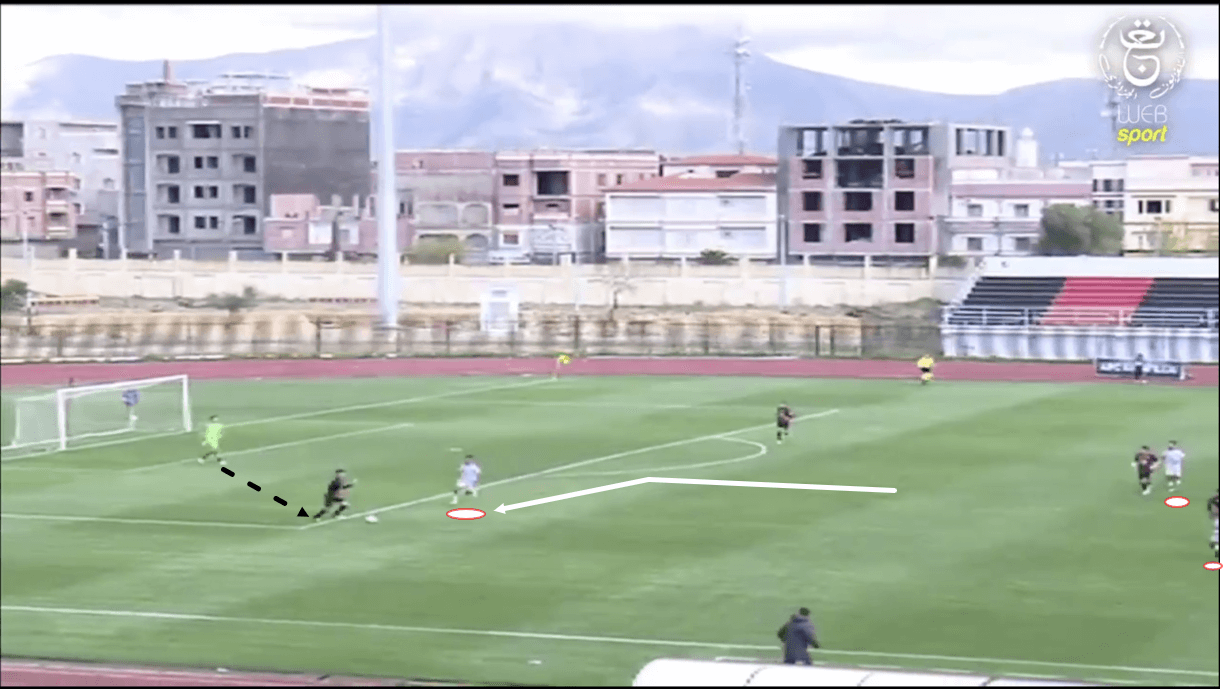
Saoura tend to defend in a 4-2-3-1 and their four attackers play a particularly important role in this system, especially during the early stages of opposition build-up, as seen in figure 1, where Saoura’s centre-forward is aggressively pressing the opposition’s right centre-back who has just received the ball from the goalkeeper.
While this striker closes down the right centre-back, his teammates behind him closely mark the nearest passing options in the next line. The left-winger marks the opposition right-back, the ‘number 10’ marks a holding midfielder and the right-winger marks the opposition left-back.
If the opposition have four men in the next line rather than three, it’s very common to see one of Saoura’s two holding midfielders advance to mark them and join the three-man line to ensure they aren’t overloaded.
If the opposition’s wingers drop to offer support, it’s also very common to see Saoura’s full-backs follow them with a similar goal as the holding midfielder. Saoura’s objective at this stage is to cut off all near progressive passing options, forcing the ball-carrier to either play backwards, leading to Saoura’s striker putting the goalkeeper under pressure, go long, giving Saoura’s deeper players a good chance of regaining possession, especially the centre-backs via an aerial duel, or attempt to pass the ball to one of the players being marked and risk losing possession in a dangerous position.
These pressing tactics leave an obvious free man for the centre-back – his central defensive partner. The other centre-back is not being marked, however, the striker has angled his run to cut the passing lane between the centre-backs, making this pass difficult to play. There have been times where the opposition centre-back has managed to get around Saoura’s forward and play the ball across to his central defensive partner, which can nullify Saoura’s press, but that’s risky.
Saoura are aggressive defenders and this pressing style has won the ball back for them a lot, creating numerous goalscoring chances and a few goals for the title challengers. In addition to being aggressive, their press is well-organised and plenty of their players frequently demonstrate alertness and speed to react to the ball being played upfield. This helps with winning the ball back high.
As well as winning the ball inside the opposition’s half, it’s also common to see Saoura winning the ball in the middle third of the pitch, with their holding midfielders playing a pivotal role in this area.
Saoura’s holding midfielders also tend to defend very aggressively, sprinting into challenges and performing slide tackles on occasion. This can lead to the opposition baiting them into challenges before playing the ball around them or drawing a foul but Saoura opt for the high risk-high reward approach and it often pays off, with their holding midfielders regaining possession in the middle third and setting them off on the counter often.
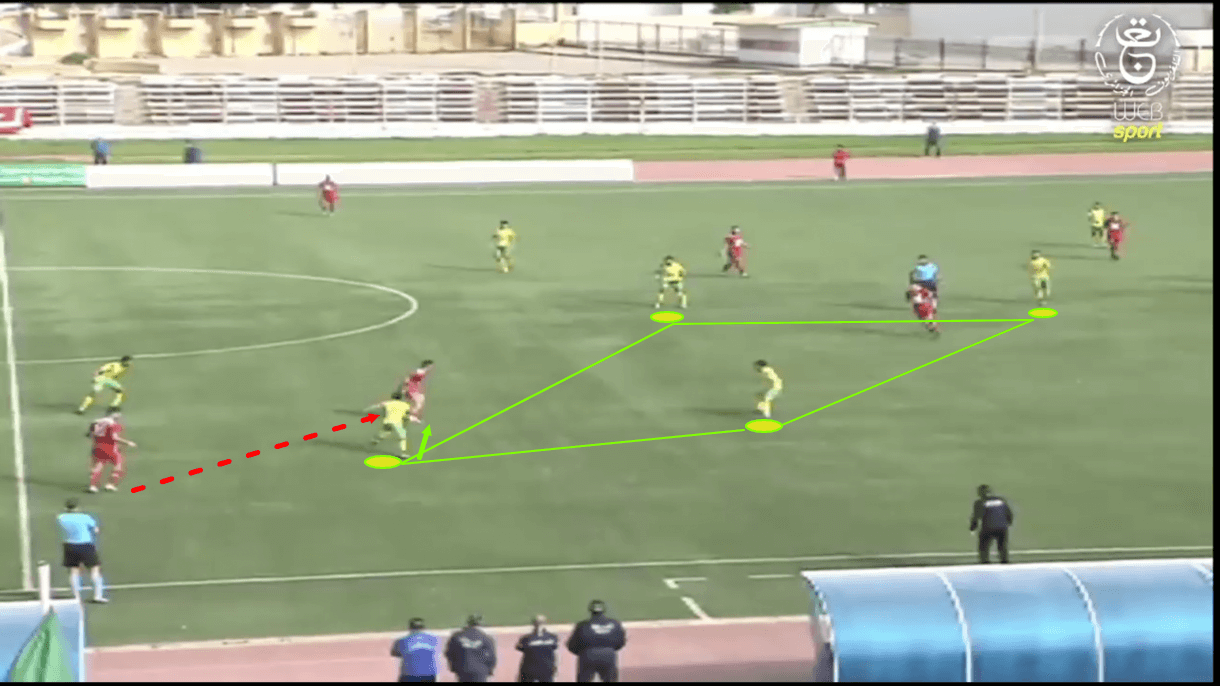
We see an example of this in figure 2. Here, Saoura’s ‘10’ is pressing the opposition ball-carrier who just received a pass in the middle third. Meanwhile, Saoura’s holding midfield duo aren’t in line with one another, as the right-sided holding midfielder has advanced his position, blocking off a potential pass into an opposition player and further congesting the middle third, making it difficult for the opposition to progress centrally.
Due to their players’ movement, Saoura have formed a rhombus around the closest forward passing option for the ball carrier, but the pass into this player isn’t blocked off. Instead of closing off all the passing options like before, Saoura are creating a pressing trap, which they often do centrally. They leave this short pass open while pressing the ball carrier to force him into a quick decision, hoping he’ll take this short passing option and put Saoura in a position to regain possession.
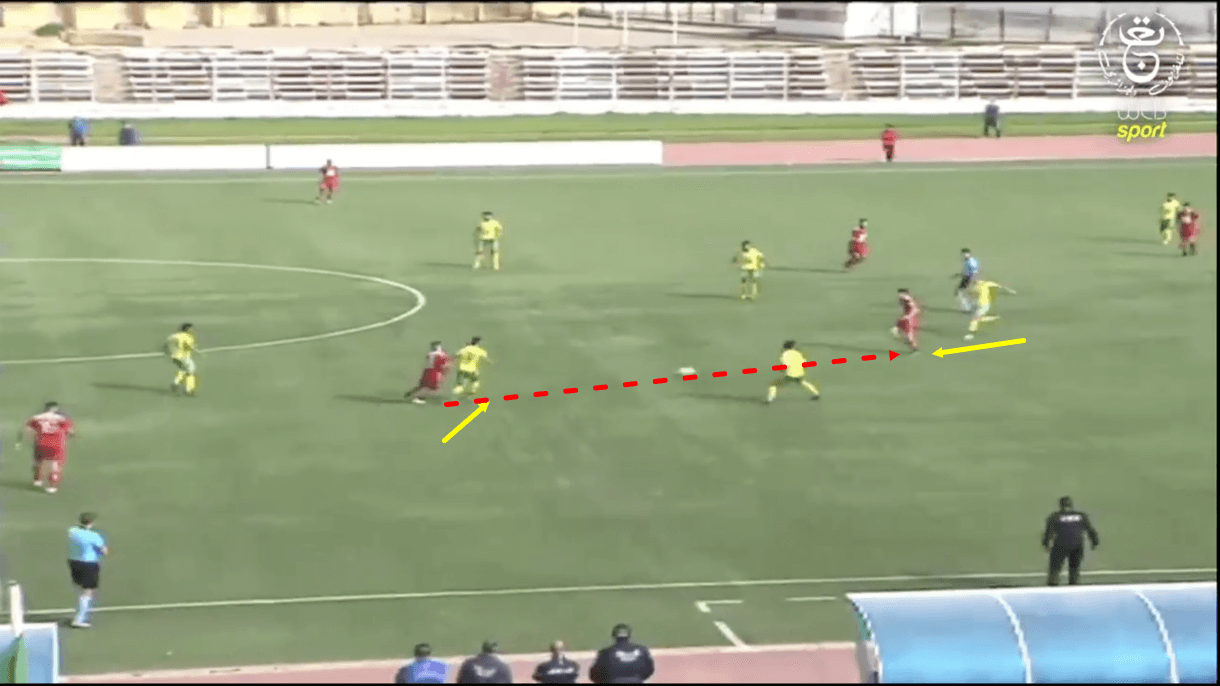
In figure 3, we see this is what happens. The aggressive ‘10’ forced the short pass and as the ball made its way to the man in the rhombus, the left-sided holding midfielder behind him pounced, getting in position to challenge from behind and make the interception, which he does before setting Saoura off on the counter. Note that the other three players who formed this rhombus also closed in on the ball receiver, limiting the space around him in case the left holding midfielder failed to make the interception, so Saoura still had a good chance of winning the ball.
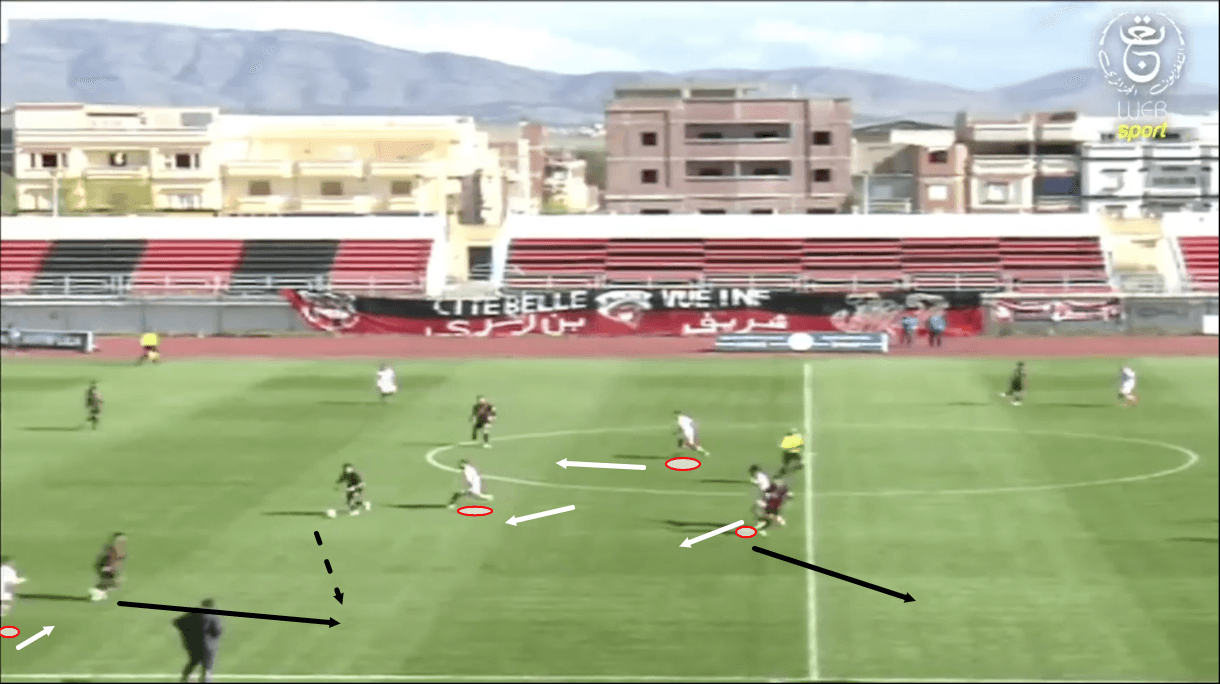
As mentioned previously, there are some weaknesses to Saoura’s pressing tactics. Firstly, just before the scenario we see in figure 4, Saoura were dispossessed centrally and the ball ended up with the man we see lining up a pass here.
Saoura actively counter-press at this moment, with the ‘10’ and holding midfielders advancing to close down this player and his nearest passing options. However, he plays a through ball to the right-back on the outside before Saoura’s midfielders challenge him or the space in front of the right-back is occupied.
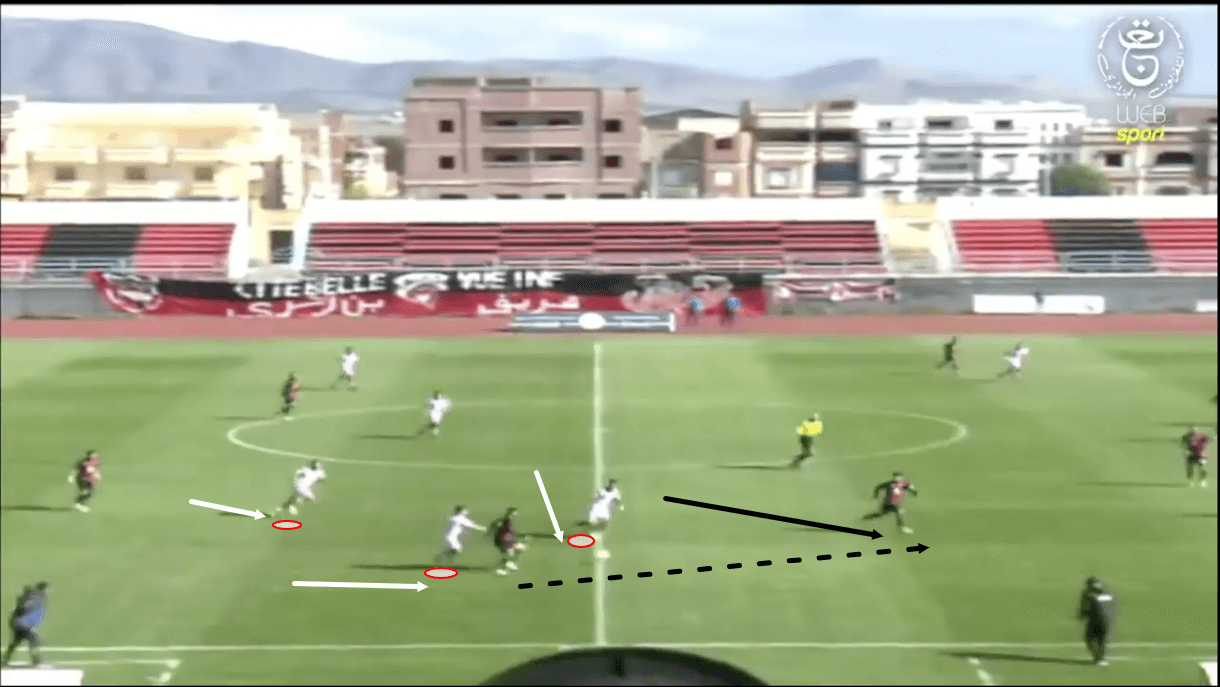
The midfielders’ attention then turns to the right-back, however, as figure 5 shows, the opposition’s right central midfielder peels away from the left holding midfielder as he presses aggressively, finding freedom in between the lines, while also in a clear position to receive a through ball from the right-back.
It wasn’t exactly straightforward for the right-back to find him in this position, as he was under plenty of pressure. However, this passage of play highlights how Saoura’s aggressive pressing tactics can be exploited by quick, one/two-touch passing plays.
The opposition can find it difficult to pull off these plays against Saoura and exploit their aggressive pressing, thus justifying the Béchar-based side’s tactics, however, if they can pull off some quick passing moves successfully, then that’s one proven way of exploiting the fact that Saoura’s defensive tactics can allow free men to be created through quick passing and movement. Saoura are particularly vulnerable to these types of plays immediately after losing possession when they’re less organised.
This area in between Saoura’s midfield and defensive lines tends to be an area of weakness for them, where the opposition often find space.
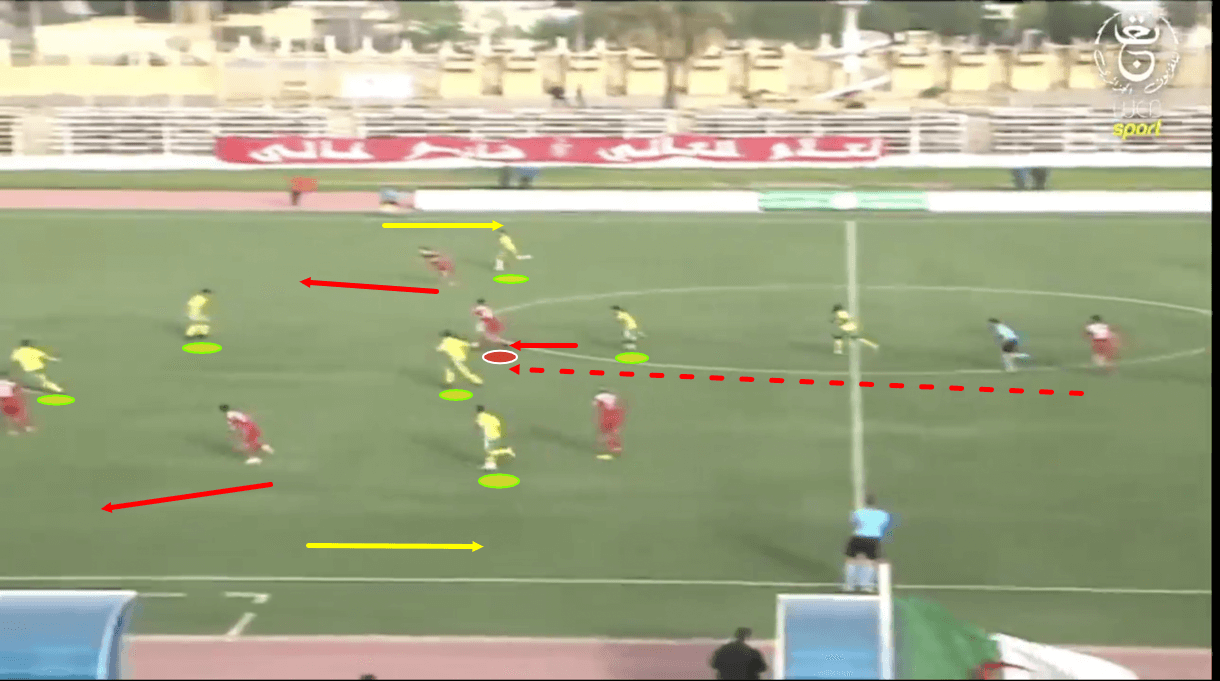
Particularly on the counter, the opposition find plenty of space in this area due to the aggressive defending style of Saoura’s holding midfielders, which can result in lots of space opening up between them and the centre-backs for opposition attackers to invade, as was the case in figure 6.
Just before this image, Saoura lost possession centrally and as Saoura counter-pressed, the player who’s now on the ball drifted into the area behind Saoura’s holding midfielders before he received a pass on the half-turn and dribbled at Saoura’s backline.
The ball-carrier has one runner ahead of him centrally, as well as one on either wing, with the wide players enjoying a lot of space in front to run into behind Saoura’s full-backs, who tend to position themselves quite high in possession.
This highlights two potential areas of weakness in Saoura’s tactics which the opposition can exploit. Firstly, the space that’s often present between Saoura’s midfield line and backline, and secondly, the space in wide areas left open by Saoura’s attacking full-backs.
JS Saoura’s tactics in the build-up
This section looks at Saoura’s tactics in the build-up. Here, we’ll provide analysis of Saoura’s offensive shape during the build-up and some notable elements of their build-up tactics, such as what kind of passes they tend to play and what kind of movement it’s common to see them make.
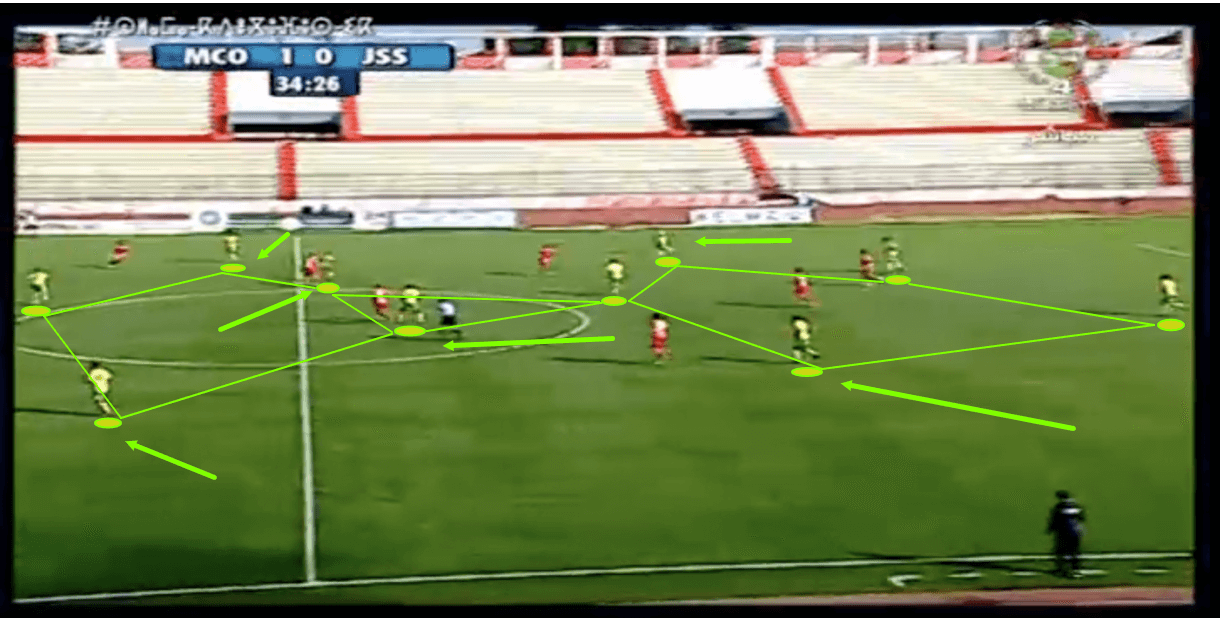
In figure 7, we see JS Saoura’s offensive 2-3-2-3 shape which they often use during the build-up. It’s common to see Saoura playing with this shape. Their full-backs advance into the line in front of the centre-backs and one holding midfielder moves in-line with the ‘10’. Alternatively, they also use a 2-4-1-3 shape sometimes. This sees the full-backs push up but both holding midfielders stay put in front of the backline.
It’s common to see both full-backs advance up the wings as Saoura progress into the opposition’s half, though one will move more centrally during the build-up at times, as the left-back has done here, to provide more short passing options and cover against counterattacks centrally.
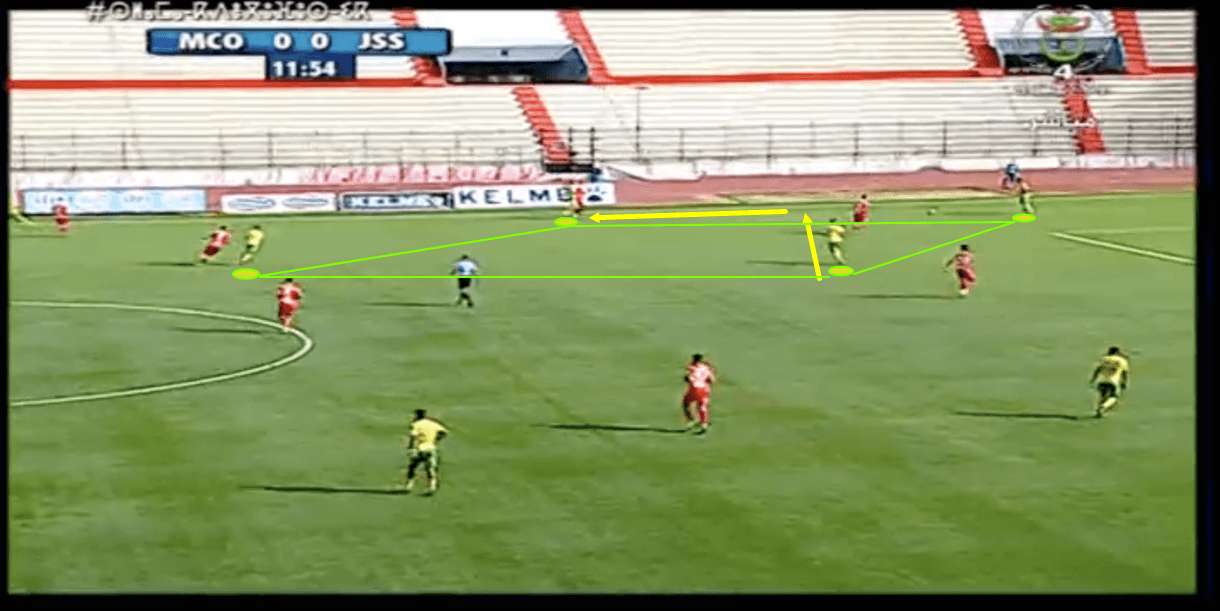
In figure 8, we see Saoura building out from the back in a 2-4-1-3 shape. We see the right centre-back in possession out wide with the right-back ahead of him and slightly wider, the right-sided holding midfielder on the other side of him and the ‘10’ ahead of him, having shifted out towards this wing to offer support. This results in a diamond shape being created. This helps Saoura to overload the opposition in this area.
Saoura often progress via the wide areas like this. A lot of their progressive passes come from the typical full-back positions. It’s common to see Saoura’s centre-backs shift out very wide during the early stages of build-up, while it’s also common to see the ‘10’ shift out wide to offer support on the side that Saoura are building through, like this.
As play progresses from situations like this, the full-backs get higher and higher while the centre-backs move back to the centre, which leaves the full-back positions open. This can weaken Saoura defensively but Saoura do exploit this space that’s been vacated in possession on occasion, with the near-sided holding midfielder drifting into the vacated full-back position to get away from his marker and find space from where he can help progress play.
This happens as play moves on in this particular example from figure 8, with the right holding midfielder shifting into the right-back position as space opens up there. So, while this space can weaken Saoura, they also use it to their advantage via intelligent movement.
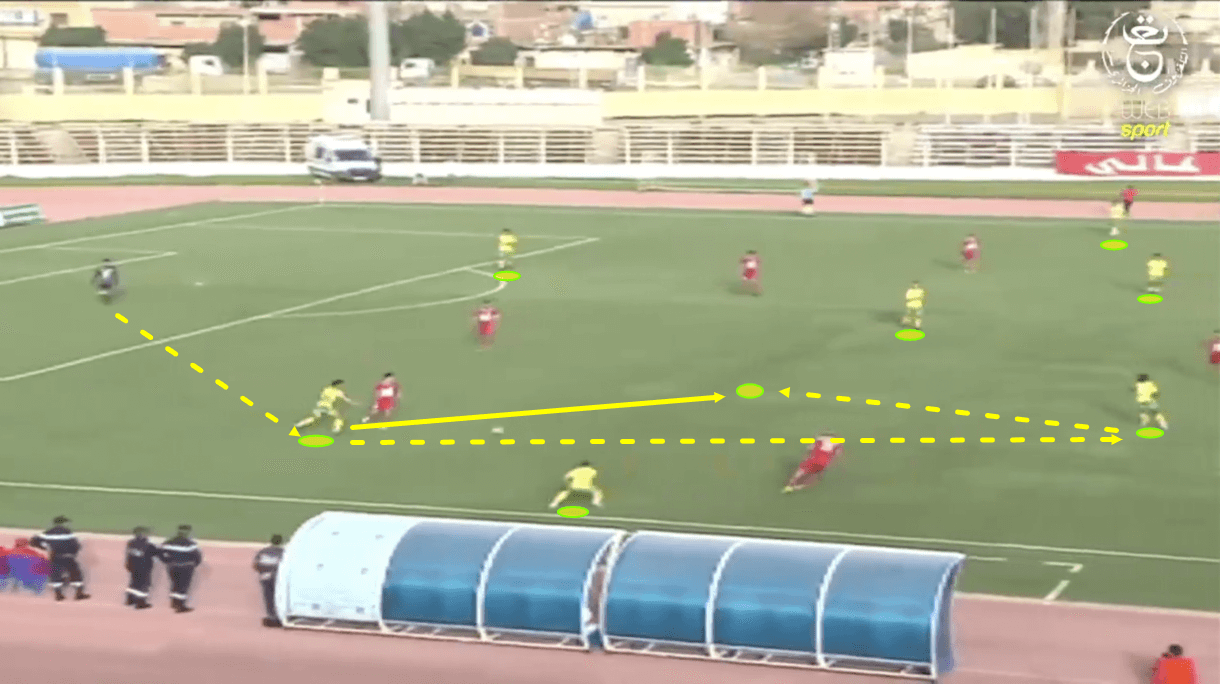
Quick short passing is a common feature of Saoura’s overall tactics in possession, including during the build-up. In figure 9, we see another example of Saoura forming their wide diamond in the build-up, as analysed in figure 8.
On this occasion, the centre-back, at one tip of the diamond, and the attacking midfielder, at the other tip of the diamond, link up with a quick one-two that sees the centre-back pass to the midfielder before moving into the more advanced, central position circled here, where he receives the ball again.
This sequence highlights how Saoura’s wide diamond in the build-up helps them to find free men with passes and advance through the thirds, while this also highlights the importance of the centre-backs’ movement in Saoura’s build-up tactics.
After moving into his wide position, the right centre-back receives the ball with his usual options to the left, right and straight ahead of him. The centre-back was quickly put under pressure from a player who also blocked off the option to his left, while the right-back was clearly being targeted by an opposition player who was ready to press aggressively if the centre-back passed to him, so he opted for the pass to the midfielder ahead of him.
This was an intelligent decision from the centre-back, as even though this player was also being pressed from behind, a pass to the right-back could’ve put that player in a worse position, as he’d also have the lack of space offered by the sideline to deal with.
As play moves on, the centre-back intelligently uses this opportunity to advance and lose his marker, becoming a free man once again by the time the advanced midfielder is under pressure so that he can receive the ball again and advance play under less pressure from a more central position.
It’s common to see Saoura’s players link up with one-touch moves like this in all areas of the pitch and it’s clear that this is something Djallit and his former mentor Ighil have coached into this team with positive results. The shape created by Saoura in the build-up as a result of their tactics also helps them to pull off these passing moves as lots of passing angles are created for them.
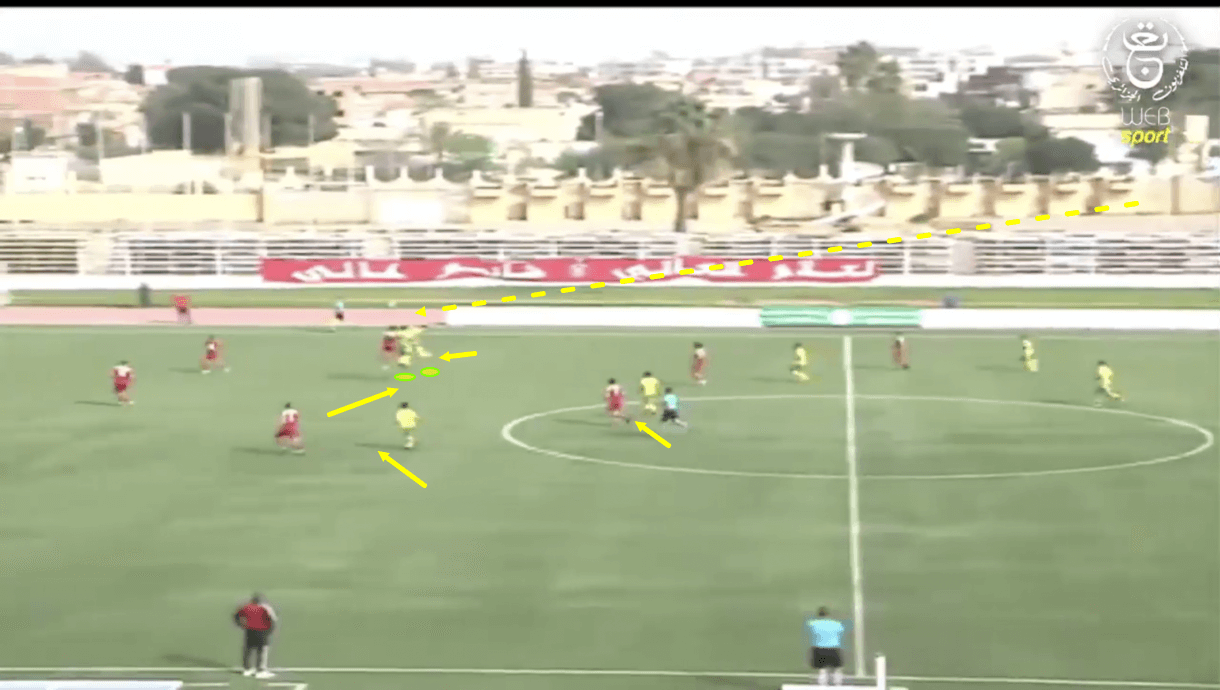
As well as these previous examples of short passing in the build-up, it’s common to see Saoura go long directly from a goal-kick, which was the case in figure 10. These passes usually go towards Saoura’s winges/centre-forward and when they opt for this approach, it’s common to see the other winger and at least one midfielder closing in around the player contesting the aerial duel, to win the second ball.
It’s also common to see the goalkeeper send the ball forward to exploit a high line, with the pass aimed for Saoura’s attackers to run onto in behind the opposition backline. This is more common when the ‘keeper has regained possession with a counterattacking opportunity presenting itself. Saoura’s centre-forward and wingers are quite pacey and this is an intelligent way of exploiting that pace.
JS Saoura’s tactics in the final third
Only two teams in Algeria’s Ligue Professionnelle 1 have scored more goals (28) than Saoura this season. As we move on into our final section, which looks at some tactical elements of Saoura’s game inside the final third, we’ll provide analysis of why Djallit’s side have been so prolific in front of goal.
This section looks at how Saoura’s fluid, quick short passing football is practised inside the final third to create goalscoring opportunities, as well as the important role their offensive full-backs play in helping Saoura to overload the opposition’s backline and create crossing opportunities.
In the previous section, we saw that quick passing and off the ball movement are important elements of Saoura’s game in possession, in terms of manipulating the opposition’s shape, creating space and progressing upfield. This is the case in early stages of build-up inside their own half as well as more advanced stages of an attack inside the opposition’s half. In the case of the latter, Saoura use this style of football to break into the final third and penalty area, to create goalscoring opportunities.
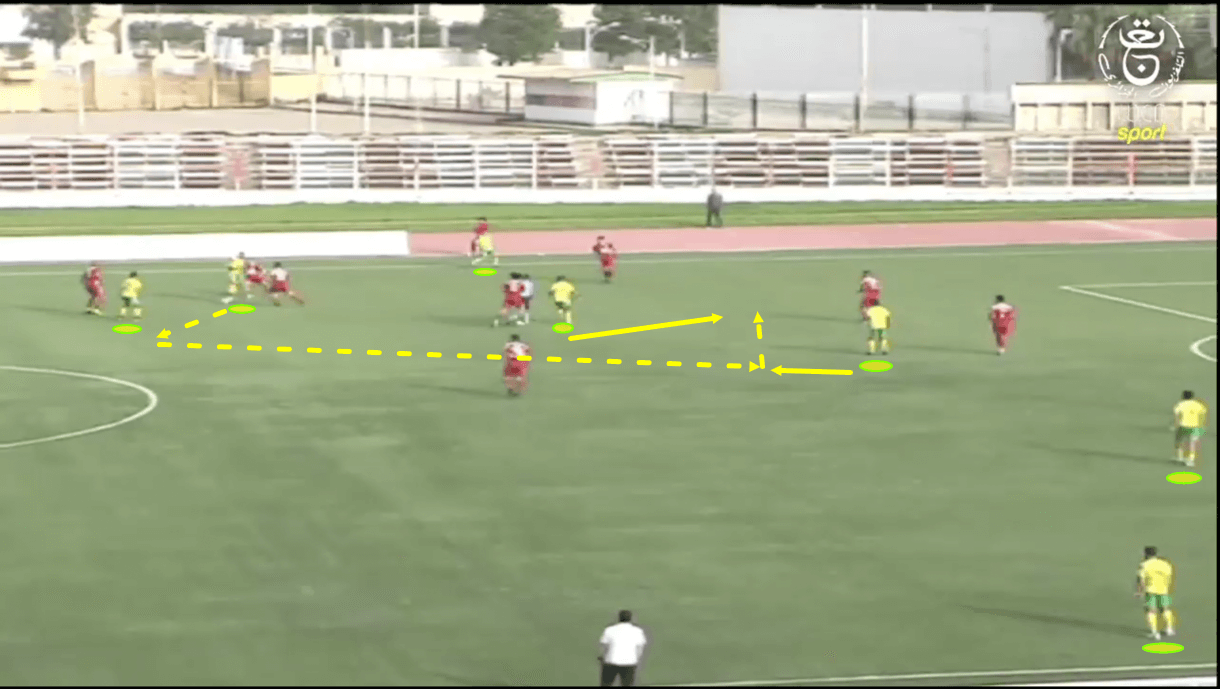
In figure 11, we see Saoura’s left holding midfielder receiving the ball in a relatively deep position compared to the rest of his teammates who are positioned in more advanced positions. As he receives the ball, he’s immediately put under plenty of pressure from the opposition’s aggressive pressers.
It would seem as though this midfielder’s nearest progressive passing options don’t have a lot of space, with the opposition defending very horizontally and vertically compact, constricting the space on this side of the pitch heavily, to make it difficult for Saoura to progress via short passes and through the centre. They are aiming to force Saoura to have to switch play and hope that this slows their attack and forces errors.
However, Saoura’s quick passing and intelligent off-the-ball movement pays off here, allowing them to play through the tight space in the centre via short passes. As play moves on, the centre-forward drops slightly, finding space in between the lines and making himself a passing option for the midfielder. The ball carrier takes this passing option and once the centre-forward gets the ball, he quickly passes it through to his teammate in the left half-space.
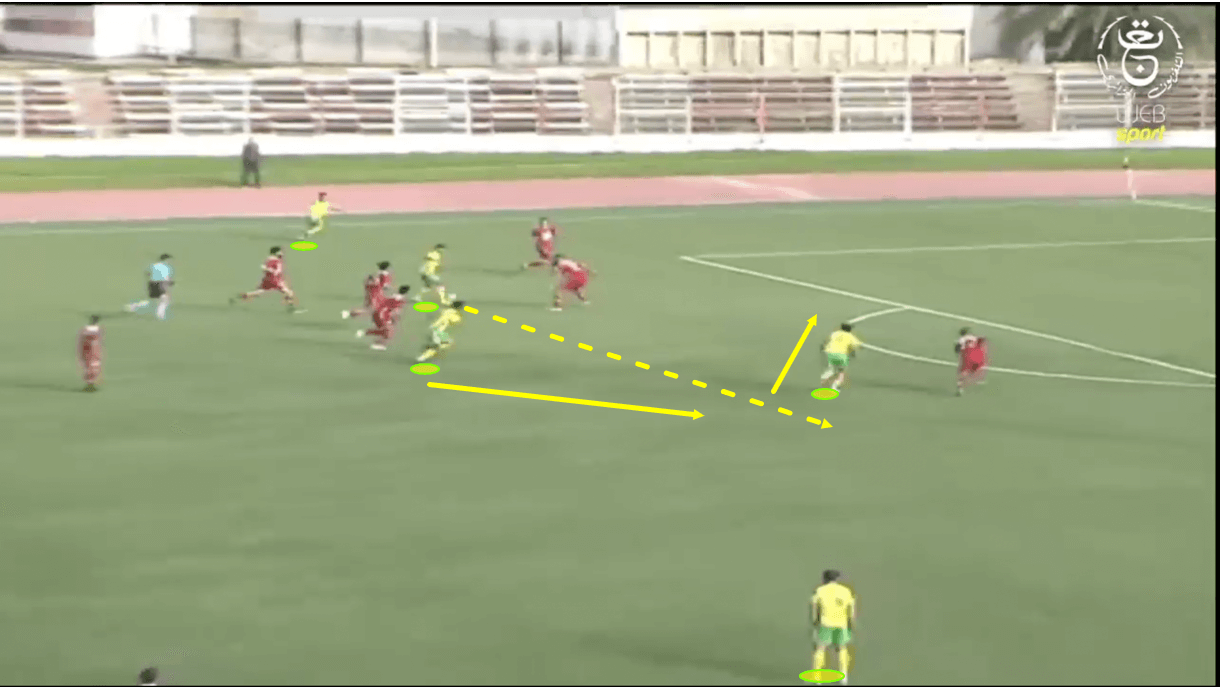
This quick passing play continues into figure 12, where the attacker in the left half-space is running at the opposition backline and attracting lots of attention from the defenders and midfielders around him.
This creates space for the other Saoura attackers, with one player overlapping into space out on the left-wing, the right-winger moving across goal into the space between the left-back and the left centre-back and the centre-forward who’d dropped deep and initially played the pass to this player running into the space being created on the right side of attack thanks to the right-winger’s movement.
The attacker in the left half-space quickly plays the ball through to the centre-forward exploiting the newly-created space on the right thanks to his teammates’ movement and this creates an excellent goalscoring opportunity.
This passage of play highlights the impactfulness of Saoura’s quick passing plays and off-the-ball movement. Despite having very little space to play through the opposition initially, they ended up slicing through them without much trouble thanks to their offensive tactics.
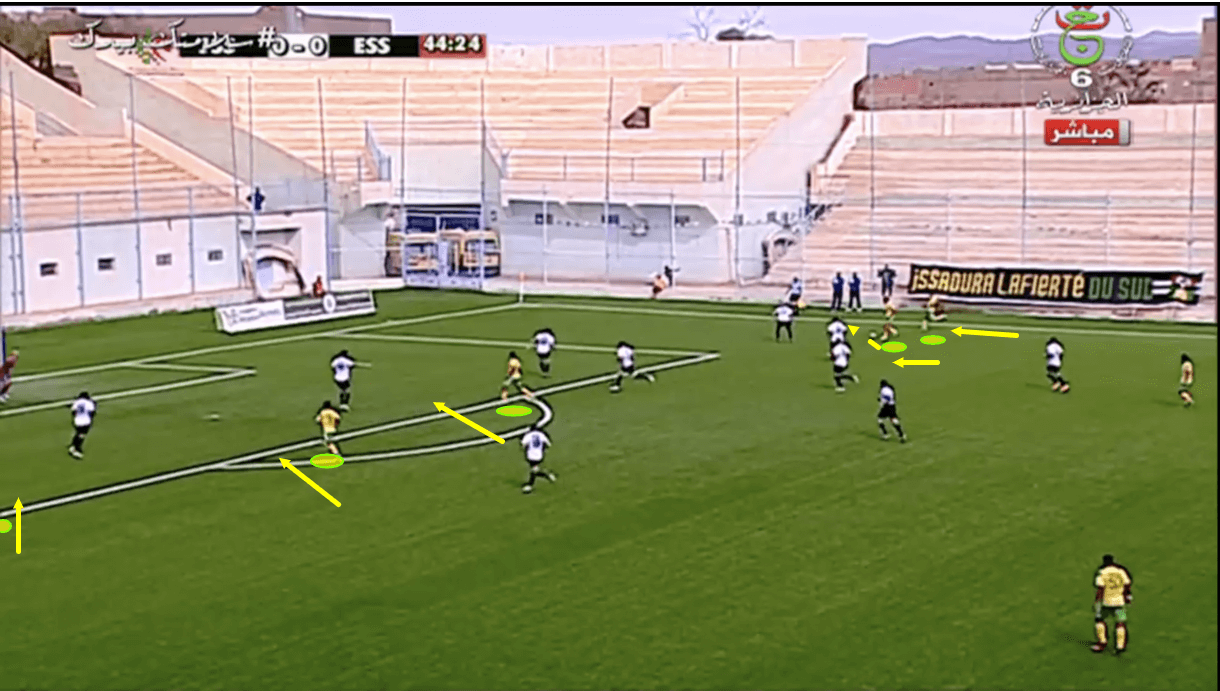
Saoura’s full-backs usually continue to advance their position further as the ball moves upfield and they often end up providing the width for their side in the final third. In figure 13, we see an example of Saoura’s right-back overlapping on the right-wing, with the near-winger on the ball, looking for his run.
By doubling up on the full-back, Saoura’s men make the defender’s job much more difficult and as play moves on, the ball is slid through to the overlapping full-back, who then manages to pull off a cross, with three men (one of whom is just out of shot here in this image) to aim for in the box.
This movement from Saoura’s right-back also helps their attack by creating space for right-winger and top scorer, Messaoudi, to move into the right half-space and attack the box more centrally, without being marked as heavily, due to the full-back being pulled out wide. So, as well as providing a crossing threat, the full-back gives plenty of help to his side’s attack just by being in this position.
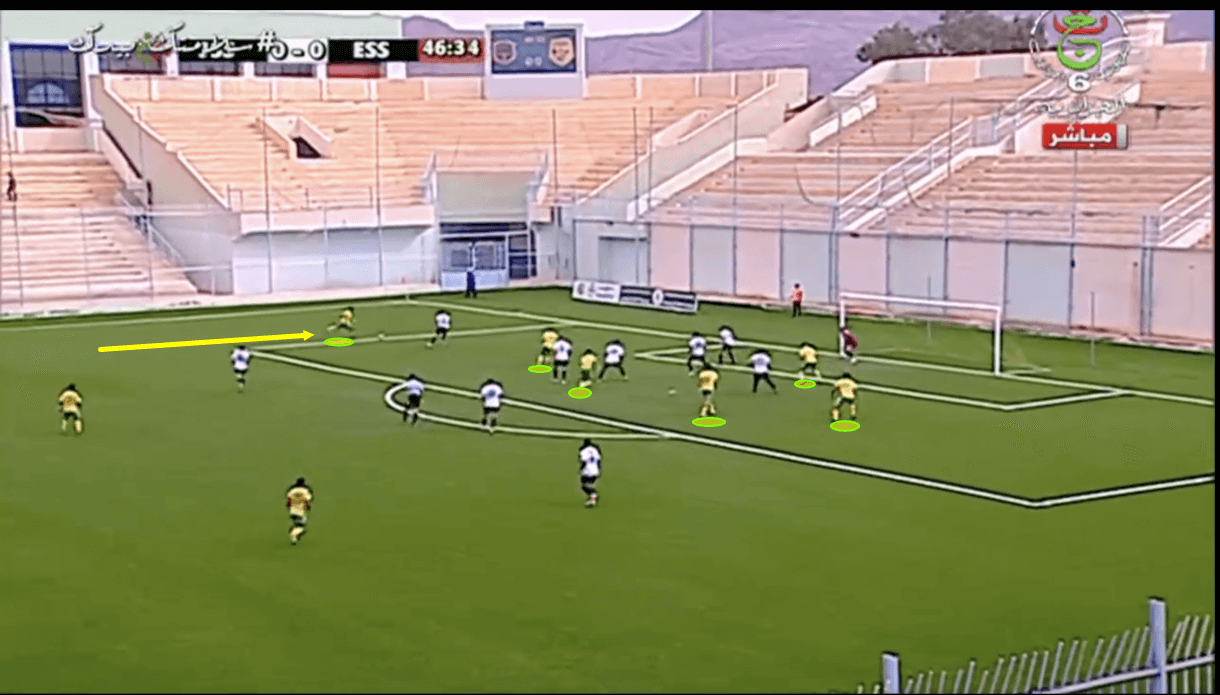
Saoura’s left-back gets forward plenty of the time as well, however, as we see in figure 14. This image also shows another element of Saoura’s tactics in the final third, which is how they often overload the opposition inside the penalty box by positioning as many as five men in the box to get onto the end of the cross. This happens as the wingers shift inside with the full-backs overlapping, joining the centre-forward and the ‘10’ in the box, while the full-back on the opposite wing will also often push into the box if a cross is on from the other side.
This can weaken Saoura defensively and leave them open to counterattacks, particularly on the wings, however, by doing this, they also often create a free man in the box to get onto the end of the cross, sometimes resulting in this player getting a free shot at goal. So, like a lot of Saoura’s tactics, this is an example of high risk-high reward.
Conclusion
To conclude this tactical analysis, in the form of a scout report, looking at JS Saoura’s title-challenging tactics in Algeria’s Ligue Professionnelle 1, it’s clear that both on and off the ball, Saoura are an aggressive team, who utilise a high-tempo.
On the ball, Saoura tend to play with lots of verticality. They mix things up during the early stages of build-up, sometimes displaying very intelligent movement in short passing sequences and sometimes opting for a more direct approach, particularly when counterattacking opportunities present themselves for the goalkeeper to exploit.
Off the ball, Saoura press high, with their front four and their holding midfield duo engaging in plenty of defensive duels and making plenty of interceptions thanks to their role in Djallit’s tactical setup. Whether or not these tactics can take them all the way to the title this season remains to be seen, but it’s clear, as Messaoudi explained, that Djallit’s tactics do suit his players, which bodes well for the near future.


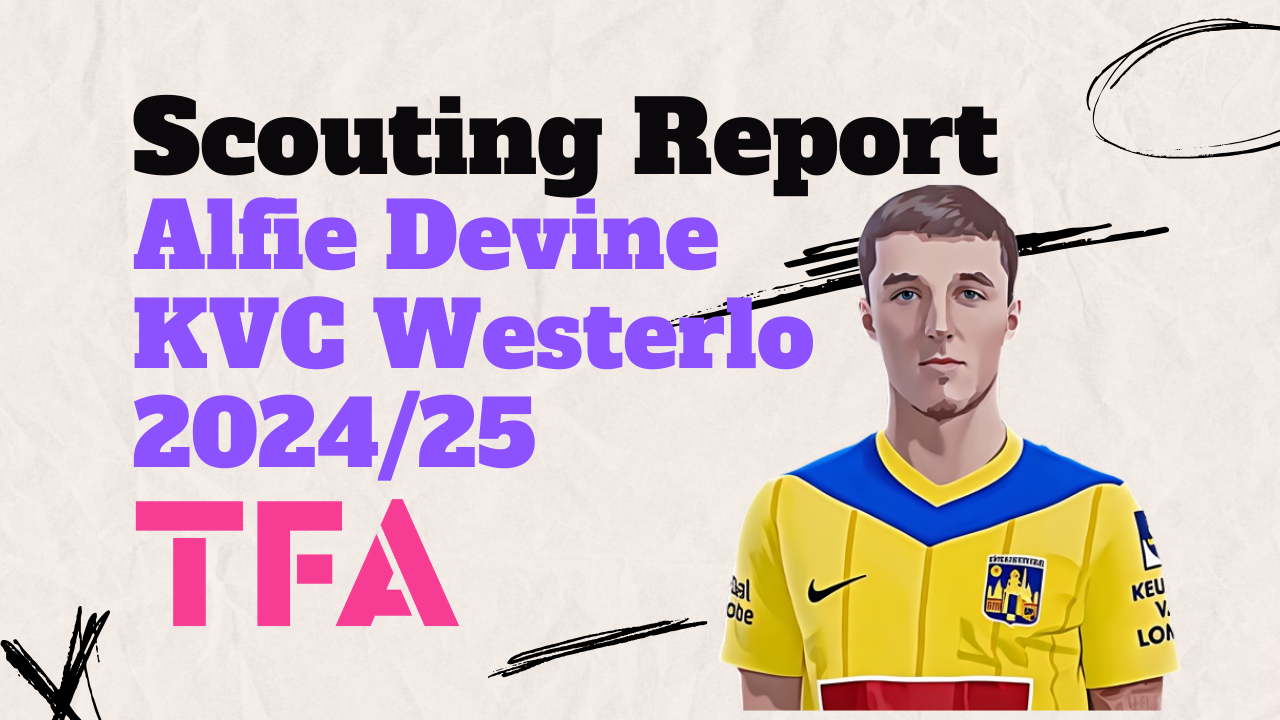
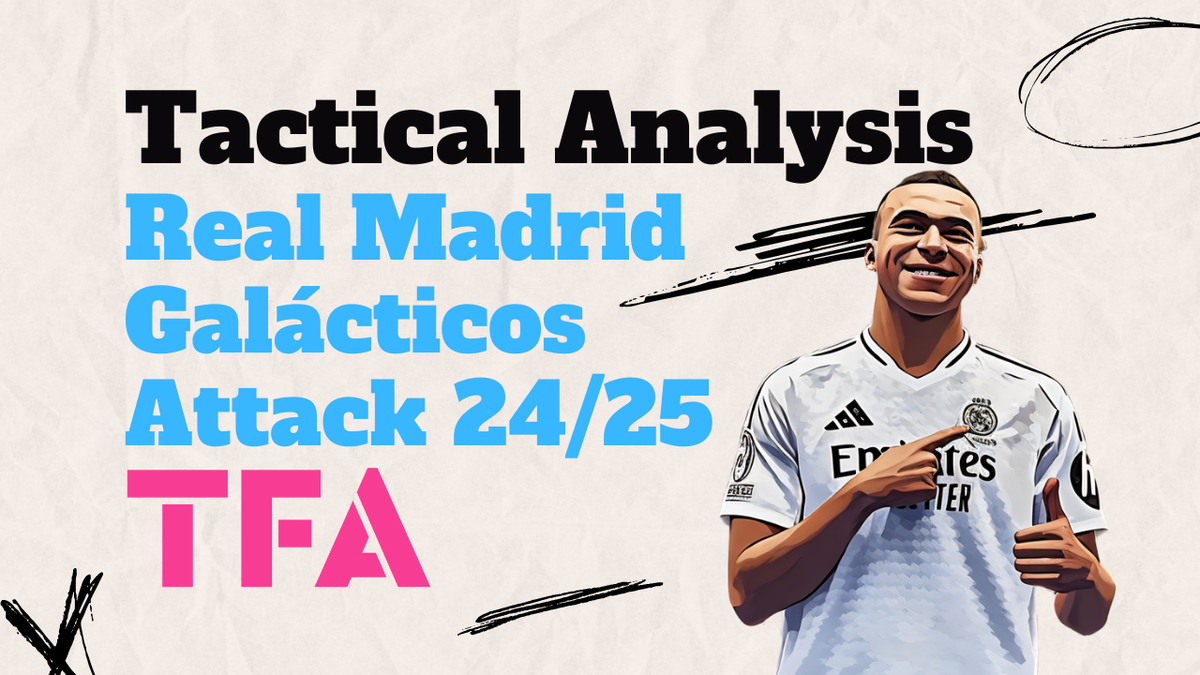
Comments